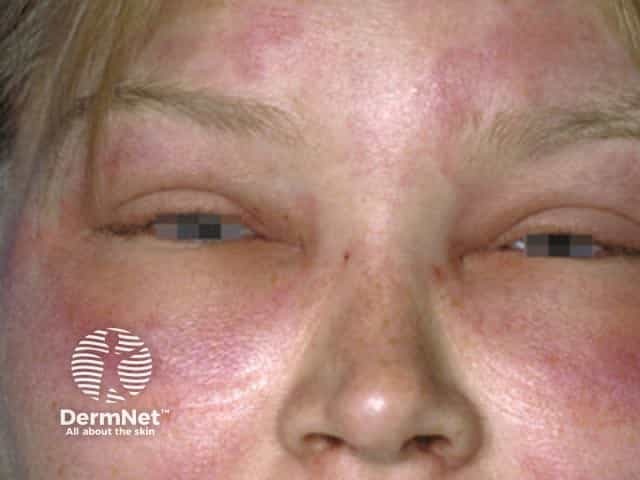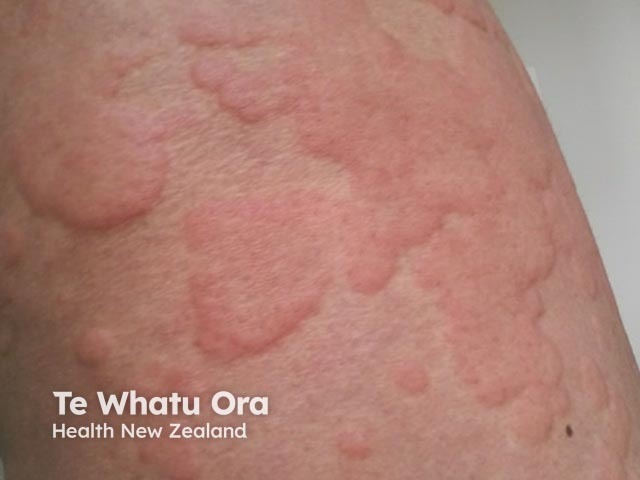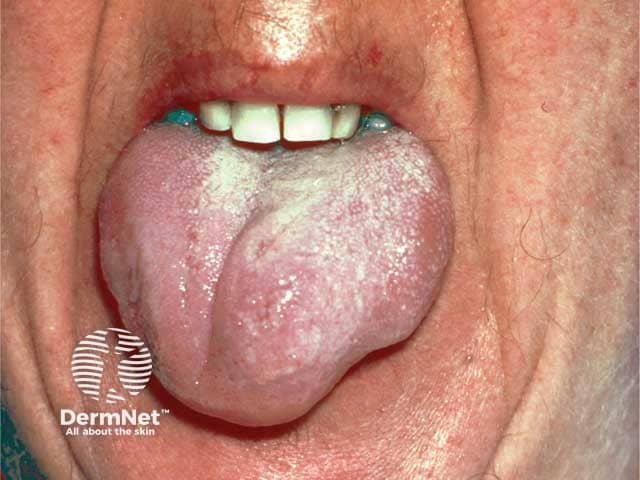Main menu
Common skin conditions

NEWS
Join DermNet PRO
Read more
Quick links
Anaphylaxis — extra information
Anaphylaxis
Last Reviewed: November, 2024
Author(s): Dr Jessica Gartside, Medical Registrar, Gold Coast University Hospital, Australia (2024)
Peer reviewed by: Dr Sarah Winter, Dermatology registrar, Welsh Institute of Dermatology, Wales (2024)
Previous contributors: Vanessa Ngan, Staff Writer (2003)
Reviewing dermatologist: Dr Ian Coulson (2024)
Edited by the DermNet content department
Introduction
Demographics
Causes
Clinical features
Variation in skin types
Diagnosis
Differential diagnoses
Treatment
Prevention
Outcome
What is anaphylaxis?
Anaphylaxis is an acute, life-threatening, systemic hypersensitivity reaction that requires immediate diagnosis and treatment.
Signs and symptoms of anaphylaxis include urticaria, angioedema, respiratory compromise, hypotension, and gastrointestinal upset.
Who gets anaphylaxis?
The estimated lifetime prevalence of anaphylaxis from all causes is between 0.05-2% in the general population, and the rate of occurrence is increasing. Mortality remains low, estimated at 0.05–0.51 per million people/year for drugs, at 0.03–0.32 for food and at 0.09–0.13 for venom-induced anaphylaxis.
What causes anaphylaxis?
Mechanisms of anaphylaxis can be classified as:
- Immunologic
- IgE dependent (classic and most frequent mechanism)
- IgE independent
- Non-immunologic (direct mast cell activation)
- Idiopathic anaphylaxis (no apparent trigger).
Any food, insect sting or bite, or medication can potentially trigger this severe reaction. The topical application of a drug to the skin or mucosae, oral, intramuscular or intravenous route, eye drops, or inhalers can all induce anaphylaxis. Antibiotics and antiseptics contained in implants and intravenous lines can also be implicated.
- Peanuts, seafood (fish and shellfish) and tree nuts (brazil nuts, almonds, hazelnuts) are the most common foods to cause an allergic reaction
- Other foods include egg, milk, wheat, soy and sesame seeds
- Food allergy is common in children and reactions can be triggered by eating, inhaling, or touching the allergen
- Reactions are usually immediate and can be severe although fatalities are rare
- Penicillins are the most common medical cause of anaphylaxis
- Other antibiotics include cephalosporins, trimethoprim + sulphamethoxazole, ciprofloxacin, sulfa drugs, tetracyclines and vancomycin
- Antiseptics and disinfectants
- NSAIDs such as aspirin, naproxen, ibuprofen and diclofenac
- Anaesthetics, muscle relaxants and opioid analgesics
Insect stings
- Bees and wasps (Hymenoptera) inject an insect venom which can cause anaphylaxis
- Local swelling and urticaria are much more common than systemic anaphylaxis
Other causes
- Latex rubber
- Vaccine components
- IV radiocontrast media
- Blood substitutes and perfusion solutions
What are the clinical features of anaphylaxis?
Food-induced anaphylaxis often produces skin reactions and respiratory symptoms while drug- or venom-induced anaphylaxis more often produces shock. Symptoms usually occur within 5–60 minutes of contact with the allergen, but sometimes happen after several hours, or even 3–4 days later. Fast onset and rapid progression of symptoms usually indicate severe, life-threatening anaphylaxis. One or more organ systems may be involved.
Typical features include the following:
Skin and mucosal
- Occur in up to 90% of reactions
- Pruritus (itch) either localised or general
- Urticaria (hives), red skin rash, and angioedema (swelling)
- The skin may feel hot and flushed

Acute angioedema of the face and lids during an attack of anaphylaxis

Severe acute urticaria during an anaphylactic attack
Respiratory
- Occur in up to 85% of reactions
- Shortness of breath, throat tightness, coughing, sneezing, wheeze, stridor, change in voice quality
- Upper airway obstruction indicated by nasal congestion, swelling of lips or tongue, hoarseness
Cardiovascular
- Variable but can occur in up to 45% of episodes
- Collapse, syncope, dizziness, tachycardia, hypotension
Gastrointestinal
- Variable but can occur in up to 30% of episodes
- Stomach cramps, nausea, vomiting and diarrhoea
Systemic
- Confusion, dizziness
- Tremor
- Collapse
Temporal patterns of anaphylaxis include uniphasic (most common), biphasic, protracted, refractory, and delayed. After apparent initial recovery, up to 3-20% of patients may relapse (biphasic response).
How do clinical features vary in differing types of skin?
See Urticaria and Angioedema
How is anaphylaxis diagnosed?
As per the World Allergy Organisation (WAO), anaphylaxis is highly likely when either one of the following two criteria are fulfilled:
-
Any acute onset of hypotension or bronchospasm or laryngeal involvement after exposure (minutes to several hours) to known or probable allergen, even if typical skin features are not present
-
Any acute onset illness with simultaneous involvement of the skin, mucosal tissue, or both (eg, generalised hives, pruritus or flushing, swollen lips-tongue-uvula) PLUS involvement of respiratory, cardiovascular, or persistent severe gastrointestinal symptoms (see WAO for specific details).
Serum tryptase measurements should be obtained (ideally within 2 hours of the episode) and reviewed. Elevated tryptase levels support a diagnosis of anaphylaxis, however normal levels do not exclude anaphylaxis.
What is the differential diagnosis for anaphylaxis?
- Acute generalised urticaria
- Non-allergic angioedema
- Acute facial contact dermatitis
- ACE inhibitor-induced angioedema
- Dermatomyositis
- Hereditary and acquired C1-esterase inhibitor deficiency
- Systemic mastocytosis
- Acute asthma exacerbation
- Syncope/fainting
- Superior vena cava obstruction
- Panic attack
- Neurologic event e.g. seizure, stroke
- Foreign body aspiration

Severe lingual angioedema in acquired C1 esterase inhibitor deficiency
What is the treatment for anaphylaxis?
Prompt recognition and prompt treatment is critical in anaphylaxis. Stop delivery of any potential causative agent. Acute anaphylaxis must be treated as a medical emergency requiring hospitalisation for continued assessment and stabilisation of airway, breathing and circulation.
Lay the person flat, and do not allow them to stand or walk. Early and definitive treatment of suspected anaphylaxis with intramuscular adrenaline (epinephrine) 0.01mg/kg, to a max dose of 0.5mg IM in adults (0.5mL of 1:1000 adrenaline using an autoinjector or syringe), or as outlined by local protocol is indicated. Repeat IM adrenaline dose every 5 minutes as required. Additional treatments include supplemental oxygen, intravenous fluids, antihistamines, and intravenous corticosteroids.
Patients taking beta-blockers may respond poorly to adrenaline, with persistent hypotension and bradycardia.
General measures
- Referral to allergy/immunology specialist
- Confirm or determine the causative allergen
- Strict allergen avoidance
- Always carry an adrenaline autoinjector (EpiPen®)
- Wear a Medic alert bracelet
- Education on condition to patient, family, and close friends
- Document any allergic reactions in health records
How do you prevent anaphylaxis?
Prevention is the best medicine. All those at risk of anaphylaxis should wear a Medic Alert/emergency bracelet with full details of allergies and contact details of their doctor. In some cases, a patient or caregiver should always carry an emergency kit containing self-injectable adrenaline and antihistamine tablets. Strict allergen avoidance should be adhered to.
What is the outcome for anaphylaxis?
The prognosis of anaphylaxis is unpredictable. It can be life-threatening; hence all anaphylactic reactions are considered medical emergencies that require emergency treatment. Fortunately, the majority of anaphylactic reactions do not result in severe outcomes and mortality from anaphylaxis remains low.
Bibliography
- Anaphylaxis: emergency management for health professionals. Aust Prescr 2018;41:54. Available here
- Cardona V, Ansotegui IJ, Ebisawa M, et al. World allergy organization Anaphylaxis Guidance 2020. World Allergy Organization Journal. 2020;13(10):100472. doi:10.1016/j.waojou.2020.100472. Available here
- Simons FE. Anaphylaxis. J Allergy Clin Immunol. 2010 Feb;125(2 Suppl 2):S161-81. doi: 10.1016/j.jaci.2009.12.981. Erratum in: J Allergy Clin Immunol. 2010 Oct;126(4):885. Journal
- Yu JE, Lin RY. The Epidemiology of Anaphylaxis. Clin Rev Allergy Immunol. 2018 Jun;54(3):366-374. doi: 10.1007/s12016-015-8503-x. Journal
On DermNet
- Urticaria
- Angioedema
- Food allergy
- Drug eruptions
- Drug-induced urticaria
- Bee and wasp stings
- Allergies explained
- Exercise-induced anaphylaxis
- Tick bite induced red meat allergy
Other websites
- Dermatological emergencies — DermNet e-lectures [Youtube]
- Anaphylaxis – emedicine, the online textbook
- Anaphylactic Shock – emedicinehealth
- Anaphylaxis Campaign, UK
- Anaphylaxis Canada
- Allergy New Zealand
- Anaphylaxis Australia
- Food Allergy and Anaphylaxis Alliance
- Food Allergy and Anaphylaxis Network, USA
- Australasian Society of Clinical Immunology and Allergy
- Allergy Action
